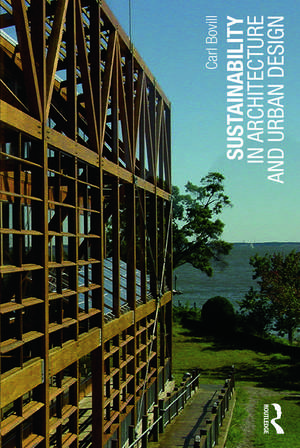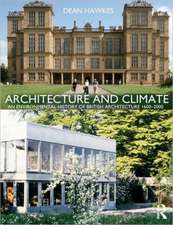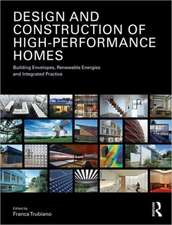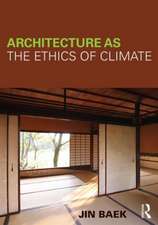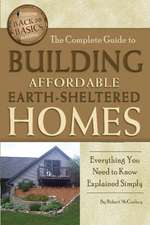Sustainability in Architecture and Urban Design
Autor Carl Bovillen Limba Engleză Paperback – 8 dec 2014
You'll learn:
-About environmental economics
-How sustainable architectural design relates to ecology
-How fractal geometry can lead to a new understanding of the structure of the world around us
-How to design energy efficient houses and commercial buildings
-How to design and live in our cities to lower energy use per person
-About LEED points at all scales
A glossary and reading lists encourage you to explore the topics further.
| Toate formatele și edițiile | Preț | Express |
|---|---|---|
| Paperback (1) | 461.03 lei 6-8 săpt. | |
| Taylor & Francis – 8 dec 2014 | 461.03 lei 6-8 săpt. | |
| Hardback (1) | 1329.36 lei 6-8 săpt. | |
| Taylor & Francis – 4 dec 2014 | 1329.36 lei 6-8 săpt. |
Preț: 461.03 lei
Preț vechi: 542.39 lei
-15% Nou
Puncte Express: 692
Preț estimativ în valută:
88.23€ • 95.80$ • 74.11£
88.23€ • 95.80$ • 74.11£
Carte tipărită la comandă
Livrare economică 22 aprilie-06 mai
Preluare comenzi: 021 569.72.76
Specificații
ISBN-13: 9780415724951
ISBN-10: 0415724953
Pagini: 284
Ilustrații: 177 black & white illustrations, 6 black & white tables
Dimensiuni: 156 x 234 x 20 mm
Greutate: 0.45 kg
Ediția:1
Editura: Taylor & Francis
Colecția Routledge
Locul publicării:Oxford, United Kingdom
ISBN-10: 0415724953
Pagini: 284
Ilustrații: 177 black & white illustrations, 6 black & white tables
Dimensiuni: 156 x 234 x 20 mm
Greutate: 0.45 kg
Ediția:1
Editura: Taylor & Francis
Colecția Routledge
Locul publicării:Oxford, United Kingdom
Public țintă
Professional and UndergraduateCuprins
Preface. Introduction. Part 1: The Global Sustainability Problem 1. Solar Energy Use through Time 2. Uncontrolled Growth 3. The Ecological Footprint 4. Global Warming and Climate Change Part 2: Ecology and the Environment 5. Ecosystem Example: The Chesapeake Bay 6. Ecology and Architecture 7. Environmental Economics 8. Nature's Geometry Part 3: The Residential Scale 9. Building Example: Watershed House 10. LEED For Residential Building Points 11. The Energy Design Process 12. Bioclimatic Design 13. Solar Control and Shading 14. Passive Solar Heating 15. Passive Cooling 16. Embodied Energy and Thermal Mass 17. High Insulation Levels 18. Material Choices Part 4: The Commercial Scale 19. Building Example: The Chesapeake Bay Foundation Building 20. LEED For Commercial Buildings 21. Daylighting 22. Electric Lighting 23. Heating and Cooling 24. Indoor Air Quality 25. Green Roofs 26. Material Choices Part 5: The Urban Scale 27. Urban Example: San Francisco 28. LEED For Neighborhood Development 29. Urbanism 30. Transit Oriented Development Part 6: Energy Sources 31. Conventional Fuels: Coal, Oil, and Natural Gas 32. Alternative Energy Sources. Appendix A Sun Path Diagrams. Appendix B Energy Analysis Computer Programs. Bibliography. Index
Notă biografică
Carl Bovill is an associate professor in the School of Architecture, Planning, and Preservation at the University of Maryland where he teaches materials, environmental controls, and sustainability. His publications include Architectural Design, Integration of Structural and Environmental Control Systems (1991) and Fractal Geometry in Architecture and Design (1996).
Recenzii
'We do not know yet what the transition from our increasingly precarious existence to something more durable and decent will require of us. But we do know that time is short, the stakes are virtually total, and the opportunities to do much better are numerous. Carl Bovill in Sustainability in Architecture and Urban Design outlines the severity of this problem and provides guidance toward solutions at the building and urban scales.' - David W. Orr, Counselor to the President, Oberlin College and Stephen A. Minter Fellow, the Cleveland Foundation, USA
‘Bovill's succinct introduction defines the thesis of his book. Bovill (Univ. of Maryland) argues that "Nature provides the pattern for a resilient sustainability" and "Creating ... a response to sustainability issues requires a broad understanding of the problem and a broad understanding of multiple solution paths." Through six parts and 32 chapters, he covers a broad range of topics, from the problem at hand to alternative energy sources for a sustainable future. Summing Up: Recommended. Graduate, research, and professional collections.’ – CHOICE, L. B. Allsopp, University of Oregon
‘Bovill's succinct introduction defines the thesis of his book. Bovill (Univ. of Maryland) argues that "Nature provides the pattern for a resilient sustainability" and "Creating ... a response to sustainability issues requires a broad understanding of the problem and a broad understanding of multiple solution paths." Through six parts and 32 chapters, he covers a broad range of topics, from the problem at hand to alternative energy sources for a sustainable future. Summing Up: Recommended. Graduate, research, and professional collections.’ – CHOICE, L. B. Allsopp, University of Oregon
Descriere
Sustainability in Architecture and Urban Design will help you understand the nature of the sustainability problem and show you how to implement your design for a sustainable future.
